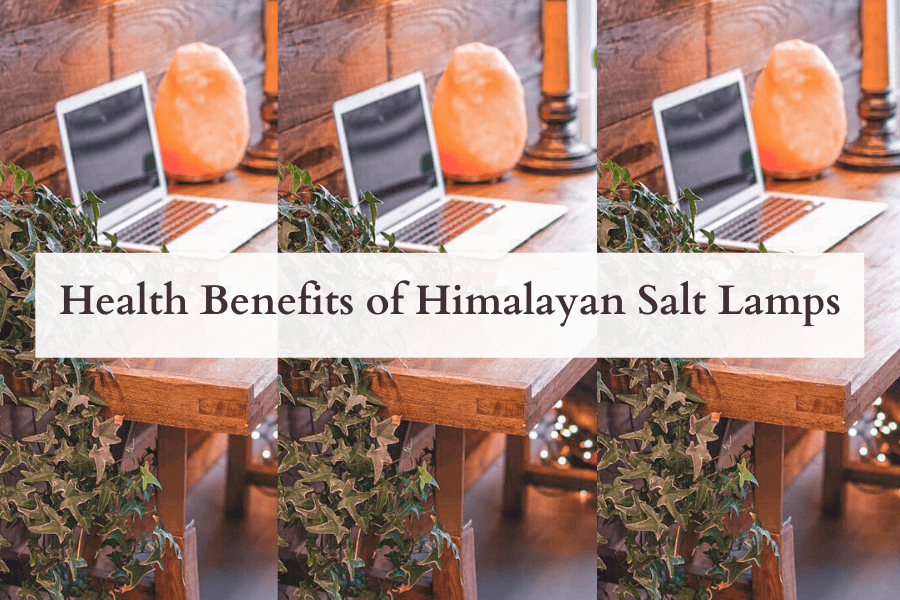You’ve probably come across these pretty, glowing lamps on a coworker’s desk or on a friend’s bedside table. Touted for their “health benefits,” these lamps have become increasingly popular around the world. But what are the real health benefits of Himalayan Salt Lamps? Are they legit… or fake news? Do salt lamps purify the air?
Keep reading to learn more about this popular wellness trend. Let’s bust some myths and see if these lamps are all that they’re cracked up to be!

(Note: This article contains affiliate links, meaning In On Around will make a small commission at no additional cost to you. This helps me maintain the site. As always, I value full transparency & only work with brands I love and trust.)
What Are Himalayan Salt Lamps?
Salt lamps are made from… you guessed it: salt (otherwise known as Sodium Chloride, which is table salt). Himalayan Salt Lamps are lamps made of a block of salt with a dimming light inside. They give off a beautiful, pink glow. They’re praised in the health & wellness world for having a long list of health benefits.
These lamps are pink because of the trace minerals found in the salt, like potassium and magnesium, which are naturally occurring on the Earth.
True Himalayan salt lamps are mined from the Khewra Salt Mine in Pakistan, which is the second-largest salt mine in the world. This is known as some of the purest salt available on Earth.
The Claims About Himalayan Salt Lamps
They sound a bit “woo woo,” but many people claim salt rock lamps come with a long list of health benefits. Salt Lamp enthusiasts say that they:
- Improve air quality & respiratory health
- Can improve the mood (especially for those with Seasonal Affective Disorder or depression)
- May improve sleep quality
- Can help with allergies or asthma
- Release negative ions into the air
Sounds pretty magical right? Let’s dig into it further…
To learn more about salt you can eat, check out: What Are The Healthiest Salt Brands? Minerals In Salt 101

What Are Negative Ions?
Salt lamps are said to be “ionizers,” meaning they release negative ions into the air. These ions supposedly change the electric charge of the air, thereby impacting your health. They’re said to “clean the air.”
Think back to your days in high school Chemistry class – when there is an unbalanced amount of protons or electrons (also known as “atoms”) in a compound, they carry a charge. There are seemingly hundreds of studies that claim that negative ions make us feel “good” and positive ions make us feel “bad.”
Are salt lamps really releasing negative ions? Do salt lamps purify air?
Cosmic rays, lightning, and waterfalls are just some of the things that naturally produce negative ions and release them into the air. The science on how they impact our health is split and they can be detected using a mass spectrometer machine… but do salt lamps even release these so-called healthy ions? [1]
The unfortunate truth about Himalayan Salt Lamps: they’re mostly FAKE news!
While I hate to break the news to you lamp enthusiasts, the claims about salt lamps are unfortunately very misleading.
Salt is a very stable compound and it needs to be very, very hot, like 1,500 degrees Fahrenheit, to dissociate the two ions. So, sorry… your salt lamp is not releasing negative ions into the air like you thought it would.
What Are The Real Health Benefits of Himalayan Salt Lamps?
While these Himalayan salt lamps may not be releasing negative ions into the air, they still have some benefits! Salt lamps:
- Can help to improve anxiety & mood [2]
- While exposure to negative ions has been shown to increase serotonin levels (aka “the happy hormone” or the hormone that stabilizes our mood), this hasn’t been linked specifically to the salt in salt lamps. [3] What could be helping mood levels, is having a dim lamp on in the first place (whether it’s a salt lamp or not). [4]
- May improve memory [5]
- This is most likely because you’re less anxious
- The dim lighting may help get in the sleepy-time mood, however, this is not because of the salt.
- Exposure to bright, blue light before hitting the hay can confuse your circadian rhythm (your sleep cycle) and keep you up. [6] Make sure to use dim lighting for the hour or two before you get ready for bed. Many salt lamps come with a dimmer switch.
- Exposure to red light (which is what’s usually emitted from a salt lamp) does not impact the body’s circadian rhythm, so it’s a great light source to use before bed. This is even confirmed by the United States Centers for Disease Control & Prevention (CDC). [7]
- Read more about red light therapy: Red Light Therapy At Home: Uses, Benefits, and Risks.
- Read more about insomnia: Struggling With Insomnia? 18 Tips For High-Quality Sleep
- They help to create a cozy home environment!
- Although salt lamps may not be all that they’re cracked up to be, they are definitely aesthetically pleasing. They’re the cutest addition to any bedside table or desk and provide a soft, warm light. In other words, for decoration purposes, they’re great!
There is little to no evidence that salt lamps improve the air quality,

Are Himalayan Salt Lamps Fake?
There’s a large market for counterfeit or imitation salt lamps that are not sourced 100% from Pakistani salt crystals. Be wary… especially if they’re dishing out big bucks ($$$) for a “quality” salt lamp.
Pro Tip: Salt lamps don’t provide any health benefits different than regular dimmable lamps. Yes, they’re pretty (I have one and love it for the aesthetics)… but don’t bother sourcing a 100% pure Himalayan lamp. Either way, it’s made from sodium chloride… whether it truly came from Pakistan or not. Your wallet will thank you.
Are Rock Salt Lamps Safe? Are Salt Lamps Toxic?
There can certainly be risks to owning a Himalayan or rock salt lamp.
- They can be toxic to pets!
- Unfortunately, some cats have died from excessively licking the salt lamps. This can be really tempting because of its texture and taste, but it can cause sodium poisoning/salt poisoning, as well as stomach pain, seizures, and vomiting (poor furry friends)! Please make sure you keep your salt lamp away from a cat or dog. [8] You don’t want them ingesting too much salt!
- As with most lamps, they are a fire hazard!
- Many dimming lights can overheat and ignite. Be very cautious and ensure the lamp is only on when you are monitoring it. Keep it away from other objects that may catch fire. Of course, all faulty electrical equipment carries this risk. Salt lamps may not be safe to leave on for long periods of time.
- True salt lamps should be hollowed out in the center so the light bulb is not touching the salt. Otherwise, the salt can “cry” or drip moisture, which can damage wires.
- Keep out of reach of young children. Much like with pets, these lamps are tempting to lick & eat!
- Too much salt can cause a host of issue like gastric distress and even seizures (uh oh). They’re also fairly heavy, which can be a danger around youngsters. Better to position them away from reach.
Alternatives To Himalayan Salt Lamps (That Actually Work)
- Use food-grade, pure sea salt in your food & water to increase your mineral uptake.
- To learn more about the best salt brands, check out: What Are The Healthiest Salt Brands? Minerals In Salt 101
- Invest in a high-quality air purifier, like Air Doctor. (discount link)
- Read more about air purifiers here: Are Ozone Air Purifiers Safe? Best Air Filter Buying Guide
- Add real plants to your home to help cleanse the air.
- Wear blue-light blocking glasses at night for the reddish “tinge” and to prevent insomnia.
- Spend time out in nature (like around waterfalls) if you’re looking for negative ions.
Pin this article to reference it later! ↓

Do Salt Lamps Purify Air – In Summary
Unfortunately, besides looking pretty on your bedside table and providing the same benefits that most dim red lights provide, Himalayan Salt Lamps don’t live up to all the hype. They do not purify the air, as they’re usually marketed. I wouldn’t call them a “gimmick,” since they do provide some benefits, but they certainly don’t release negative ions into the air to drastically improve your health. Another health myth busted!
Frequently Asked Questions
Click on the below FAQs to learn more!
What are Himalayan salt lamps?

Salt lamps are made from… you guessed it: salt (otherwise known as Sodium Chloride). Himalayan Salt Lamps are lamps made of a block of salt with a dimming light inside. They’re praised in the health & wellness world for having a long list of health benefits. These lamps are pink because of the trace minerals found in the salt, like potassium and magnesium, which are naturally occurring in the Earth.
Are the health benefits of Himalayan salt lamps real?
How do you find real salt lamps?
Are salt lamps dangerous?

Keep salt lamps out of reach of young children. Much like with pets, these lamps are tempting to lick & eat! Too much salt can cause a host of issue like gastric distress and even seizures (uh oh). They’re also fairly heavy, which can be a danger around youngsters. Better to position them away from reach.
Do you own a Himalayan Salt Lamp?
If you own a salt lamp, does it help to improve your mood and sleep? Let me know in the comments below! You can watch our web story here.
Please rate & review this article – I would love to hear what you think.
xoxo,

Want to read more? Check out my other articles here!
Information on “Do Salt Lamps Purify Air” from: Cleveland Clinic, Healthline, Veritasium, Live Science, Houstonia, Negative Ionizers, Reuters, NPR, Austria Forum, Bustle
Copyright In On Around LLC 2021 ©. The statements made on this website have not been evaluated by the FDA (U.S. Food & Drug Administration). They are not intended to diagnose, treat, cure, or prevent any disease. The information provided by this website should not be used as individual medical advice and you should always consult your doctor for individual recommendations and treatment.











